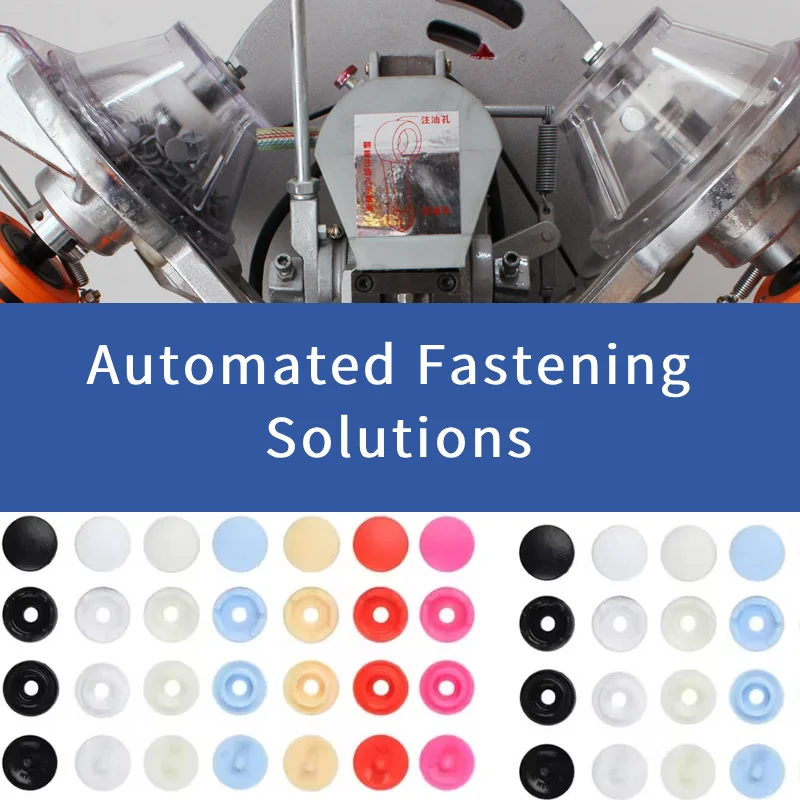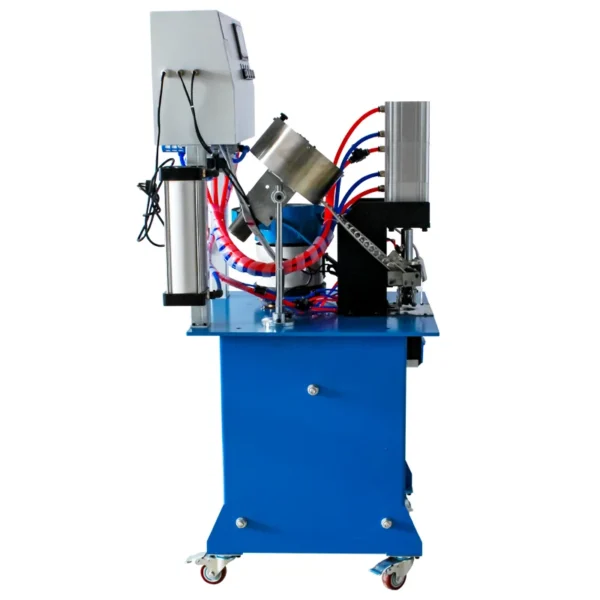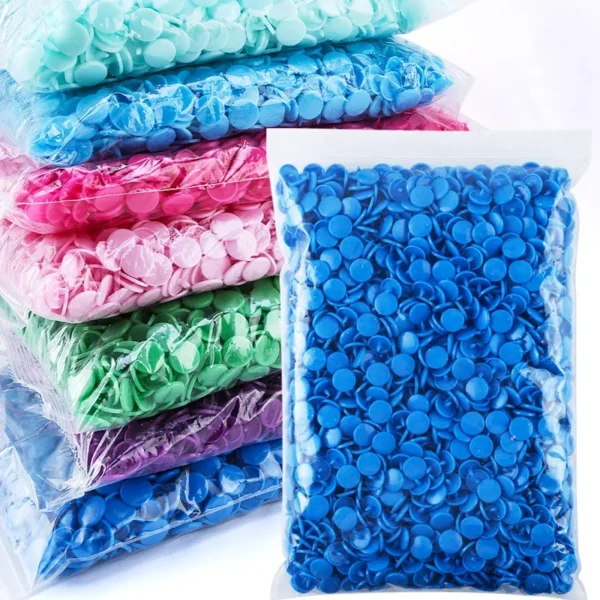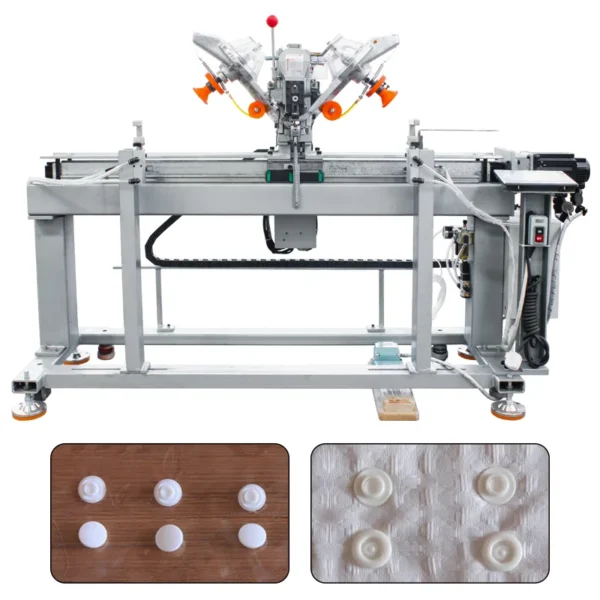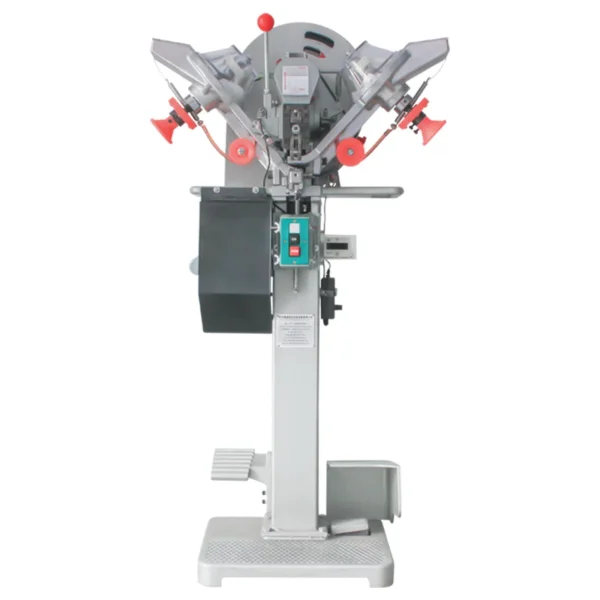When parents pick up a baby bodysuit, they’re usually focused on softness, cuteness, or brand — not the engineering that makes those tiny snaps click perfectly every time. Yet behind every onesie that fits comfortably and closes smoothly lies a story of precision, consistency, and care.
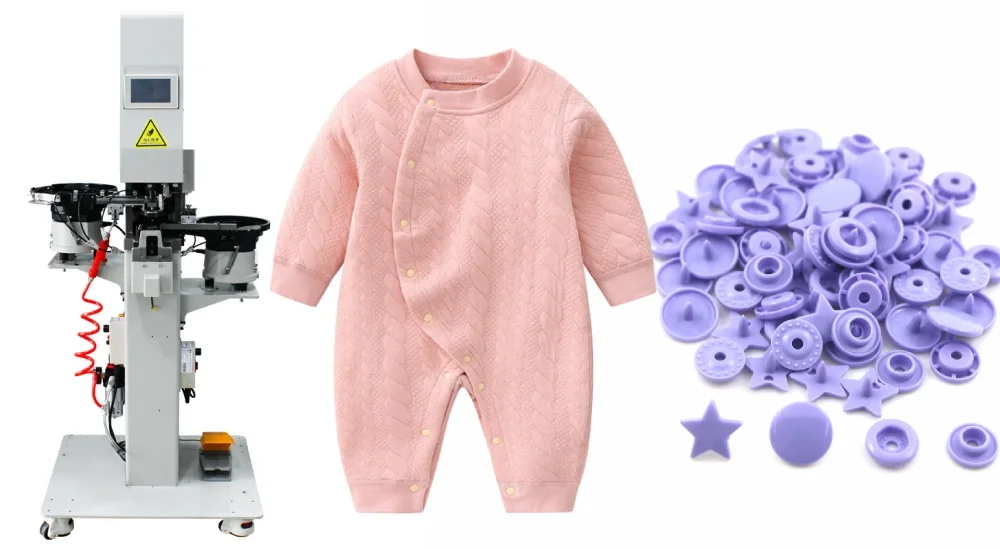
For us, as manufacturers of Automatic Snap Button Machines, babywear represents more than just another product category. It’s a test of absolute gentleness and control. Babies’ skin is ultra-sensitive, so even the smallest metal burr, misaligned snap, or over-pressed fastener could cause irritation or pose safety risks. We’ve spent years perfecting machines that balance power with delicacy — and nowhere is that expertise more crucial than in baby bodysuit production.
When we first started working with children’s garment factories over a decade ago, most relied on semi-automatic or manual presses. Quality control was a nightmare — uneven pressing, button slippage, and inconsistent spacing. Over time, we realized that the solution wasn’t more labor; it was smarter automation. That realization gave birth to our Multi-Head Automatic Snap Button Machine, purpose-built for babywear, where safety, softness, and style come together.
Why Snap Buttons Define the Comfort and Safety of Baby Clothing
If you’ve ever tried to dress a squirming baby, you know how vital snap buttons are. They need to open and close smoothly with minimal effort — yet stay secure under stress. For baby bodysuits, these snaps are functional anchors, holding the garment’s shape and ensuring easy diaper changes.
But achieving that perfect snap balance is no easy task. Every button must be pressed with the right force — not too tight to damage the fabric, not too loose to risk detachment. Manual tools struggle with this precision. One extra millimeter of pressure, one tiny misalignment, and the entire garment fails inspection.
Our Multi-Head Automatic Snap Button Machine addresses this problem with intelligent pressure calibration and synchronized head control. Each head applies identical force, ensuring uniform fastening across every button. The result? Smooth closures, consistent spacing, and perfect symmetry — even after hundreds of wash cycles.
These details may seem minor, but in the babywear industry, they define brand reputation. Leading labels now require compliance with CPSIA (Consumer Product Safety Improvement Act) and OEKO-TEX Standard 100, which demand strict mechanical integrity and chemical safety. Automation helps manufacturers meet these benchmarks without compromise.
The Shift from Manual to Automated Snap Fastening
Before automation, we spent countless hours visiting workshops where workers installed snap buttons by hand. The process was repetitive, tiring, and prone to human error. We once observed an operator in a small Indonesian factory who pressed 3,000 snaps per day using a foot-pedal machine. Her accuracy rate? Around 90%. That means 300 snaps had to be redone daily — wasted labor and material.
When we introduced automation to that same factory, their reject rate dropped below 1%. The owner told us, “This machine doesn’t just save money — it saves patience.” That kind of transformation is why automation matters.
The Multi-Head Automatic Machine allows multiple snaps to be installed simultaneously. Instead of pressing one button at a time, the operator positions the garment, and all snaps on that section are applied in one smooth cycle. This not only boosts speed but also guarantees perfect alignment — something nearly impossible to achieve manually.
Automation doesn’t just replace human work; it refines it. It frees skilled workers to focus on quality checks and finishing details, letting the machine handle the repetitive precision work that demands endurance and consistency.
What Makes the Multi-Head Automatic Machine a Game-Changer
Our multi-head system was born from a simple idea: why press one button when you can press several — perfectly — at once? Each head in the machine operates independently but communicates with a central controller. This allows simultaneous yet synchronized fastening across multiple points of the fabric.
From a design perspective, this innovation revolutionized babywear production. A standard baby bodysuit has between 6 to 10 snap buttons, often applied in tight spacing around curved seams. With a multi-head machine, we can align all snaps precisely, maintaining even tension across the garment.
The machine’s pneumatic or servo-driven control system ensures consistent pressing force, while the optical alignment sensors guarantee each button is placed at the correct coordinate — down to fractions of a millimeter. What’s even better is its built-in error detection: if a button or cap is missing, the system automatically halts and alerts the operator.
One of our customers, a European babywear brand, reported a 300% increase in output after installing our 4-head machine. More impressively, their quality complaints from retailers dropped to nearly zero. They told us, “We finally trust every snap — and so do our customers.”
Inside the Machine: How It Works Step by Step
Let’s open the lid, so to speak. The Multi-Head Automatic Snap Button Machine combines mechanical precision with electronic intelligence.
Here’s a simple breakdown:
- Feeding System – Vibratory bowls automatically separate and orient the snap components (caps, sockets, studs, and posts).
- Positioning Stage – A laser-guided system or template aligns the garment under the multi-head press.
- Pressing Cycle – Each head applies calibrated force simultaneously. Sensors measure depth, pressure, and dwell time to ensure perfect fastening.
- Inspection Phase – Optical sensors verify button presence and alignment before releasing the garment.
- Data Logging – The system records every cycle for traceability and quality tracking.
This process, though fast (usually 30–60 garments per minute), is gentle on delicate fabrics like cotton interlock and bamboo fiber. It eliminates the risk of overheating or overstressing material — a common issue in manual pressing.
As a manufacturer, we designed it not only for performance but also for reliability. All key components are made from hardened steel and precision-ground alloys, ensuring stable performance even under continuous operation. Many of our machines have run flawlessly for over a decade with only routine maintenance.
Industry Standards and Safety Certifications for Babywear
When dealing with baby clothing, safety isn’t negotiable. That’s why our designs are guided by strict international standards such as CPSIA (USA), EN 71-3 (Europe), and OEKO-TEX Standard 100. These regulations govern everything from button strength to chemical composition.
Our machines help manufacturers comply by ensuring repeatable fastening force and stable joint strength. The average pull strength of our automated snap application exceeds 90 Newtons, surpassing CPSIA requirements. Moreover, our non-marking dies prevent surface damage or sharp edges — ensuring the garment passes visual and tactile inspection.
We also work with testing labs that simulate washing, tumbling, and pulling over 5,000 cycles. The results consistently show zero failure in automated snaps. This is where precision manufacturing meets peace of mind for parents and brands alike.
The Art of Precision: Consistency and Fabric Protection
Fabric protection is one of those invisible arts you only notice when something goes wrong. A single over-pressed snap can distort fabric or leave a visible ring mark. That’s why we’ve built adaptive pressure control into our machines.
Using servo sensors, the system automatically adjusts pressing force according to fabric thickness and elasticity. Whether you’re working with organic cotton, bamboo blend, or stretch jersey, each snap receives precisely the pressure it needs — no more, no less.
This consistency is what sets professional-grade babywear apart. Retailers can feel it, parents can sense it, and manufacturers can measure it. Our experience tells us that small details — like perfect snap closure sound or invisible press marks — define the perceived value of a brand.
Real Factory Insights: Lessons from Our Production Partners
We’ve partnered with factories from Bangladesh to Turkey, and every story teaches us something new.
A large babywear exporter in Vietnam told us automation helped them win European contracts that previously seemed out of reach. Why? Because their automated snap installation passed every quality audit without a single rejection.
Another client, a boutique workshop in Portugal, said the biggest advantage wasn’t just speed but freedom:
“Our operators no longer stress about misalignment. They trust the machine, and that confidence reflects in the product.”
These relationships are the backbone of our growth. Every satisfied partner is proof that automation isn’t about replacing craftsmanship — it’s about enhancing it.
Productivity and Cost Efficiency in Modern Babywear Manufacturing
The difference between profit and loss often comes down to time — and automation gives you time back.
Let’s consider numbers. Manual snap pressing typically achieves 200–300 garments per hour. A single Multi-Head Automatic Machine can process 1,000–1,500 garments per hour, depending on configuration. That’s up to five times faster — with fewer errors, lower scrap, and higher uniformity.
Labor costs drop significantly, but the bigger win is consistency. Automated data logging allows factories to trace each batch, meeting retailer demands for transparency. The investment pays off fast; most customers report full ROI within 8–10 months.
As one of our North American clients said:
“We thought automation was a luxury. Now it’s our biggest competitive advantage.”
Human-Centered Design: Simplicity for Operators
Our machines may look complex, but they’re built for simplicity. Every control panel uses intuitive touchscreen menus with multilingual support. Operators can store settings for different bodysuit models, ensuring quick changeovers.
We’ve learned that good design isn’t about adding more buttons — it’s about making every button make sense. That’s why our systems feature auto-diagnostics, tool change reminders, and even video-assisted maintenance guides on-screen.
One of our proudest achievements? Training operators in under one hour — even those with no technical background. As a result, factories report higher morale and lower turnover because workers feel empowered, not overwhelmed.
Sustainability and Waste Reduction in Automated Fastening
Automation isn’t only efficient — it’s eco-friendly. Our machines eliminate material waste from misaligned snaps, reduce energy consumption with smart standby modes, and cut noise pollution by over 30% compared to pneumatic foot presses.
By extending die life and minimizing scrap, we help factories meet sustainability targets aligned with Higg Index and ISO 14001 environmental standards. When production becomes cleaner and quieter, both workers and the planet benefit.
Smart Technology Integration: Sensors, AI, and Data Tracking
Our latest generation integrates AI-driven vision systems that inspect every snap for alignment and completeness. Real-time data collection helps quality teams analyze patterns, predict tool wear, and schedule preventive maintenance.
The machine’s network connectivity also allows remote monitoring — factory managers can view output and performance data from their phones. One customer described it as “a small revolution” because it gave them visibility they never had before.
This fusion of mechanical reliability and digital intelligence is shaping the future of textile automation — one snap at a time.
Comparing Traditional vs. Multi-Head Automatic Systems
| Aspect | Manual Pressing | Multi-Head Automatic Machine |
|---|---|---|
| Speed | 250–300 garments/hour | 1,200–1,500 garments/hour |
| Accuracy | ±1.2 mm | ±0.1 mm |
| Reject Rate | 8–10% | <1% |
| Operator Fatigue | High | Minimal |
| Fabric Damage | Common | Rare |
| ROI | — | 8–10 months |
Automation doesn’t just outperform manual pressing — it transforms manufacturing economics.
Customer Success Stories: From Workshops to Global Brands
Wholesalers and end customers alike praise the difference automation makes. A Canadian babywear wholesaler shared:
“We used to inspect every batch carefully. Since switching to automated fastening, we trust every delivery.”
Another retailer in Japan noticed that customer returns dropped significantly after automated fastening was introduced. “It’s not just stronger — it looks more professional,” they said.
Positive feedback like this reminds us why precision matters. Every satisfied parent, every comfortable baby, and every reliable factory forms a chain of trust that begins with a single well-fastened snap.
Why Our Machines Stand Out in the Market
We don’t just sell machines; we deliver performance solutions. What sets us apart is our hands-on experience — decades of field testing, real factory feedback, and continuous R&D investment.
Every model we produce goes through 1 million cycle endurance testing, ensuring durability and stability. We offer fully customizable configurations — from 2-head to 6-head systems — to match each factory’s unique workflow.
In short, we combine mechanical craftsmanship with digital intelligence, creating systems that don’t just work — they excel.
After-Sales Support and Long-Term Partnership
Automation is a partnership, not a transaction. That’s why we provide complete after-sales training, online diagnostics, spare parts support, and lifetime technical consultation.
Our engineers assist clients remotely through live video calls, ensuring minimal downtime. We also maintain regional service centers to provide faster response times.
We believe reliability extends beyond hardware — it’s about the relationship that keeps production running smoothly year after year.
Conclusion
Every baby bodysuit tells a story of comfort, care, and craftsmanship. But behind that story lies invisible precision — the kind only automation can achieve. The Multi-Head Automatic Snap Button Machine transforms babywear production by blending speed, safety, and softness into one seamless process.
As manufacturers, we take pride in knowing that somewhere in the world, a parent is dressing their baby with ease and comfort — thanks, in part, to the precision of our technology. That’s not just business; that’s purpose.
FAQs
1. Can the machine handle different fabric types like organic cotton or bamboo?
Yes. Our adaptive pressure system automatically adjusts force for each material, ensuring no damage or marks.
2. How many heads can be customized on one machine?
We offer 2, 4, and 6-head configurations, depending on garment design and production volume.
3. What is the pressing accuracy?
Each head maintains ±0.1 mm positional accuracy with servo-controlled force consistency.
4. Does it comply with safety and textile standards?
Absolutely. Machines are CE-certified, and the fastening strength meets CPSIA and OEKO-TEX safety benchmarks.
5. How long is the ROI period for most factories?
Typically within 8–10 months, depending on production scale and labor costs.
6. What support do you provide after purchase?
We offer global after-sales service, operator training, video tutorials, and lifetime technical support.

